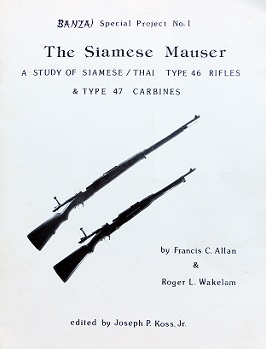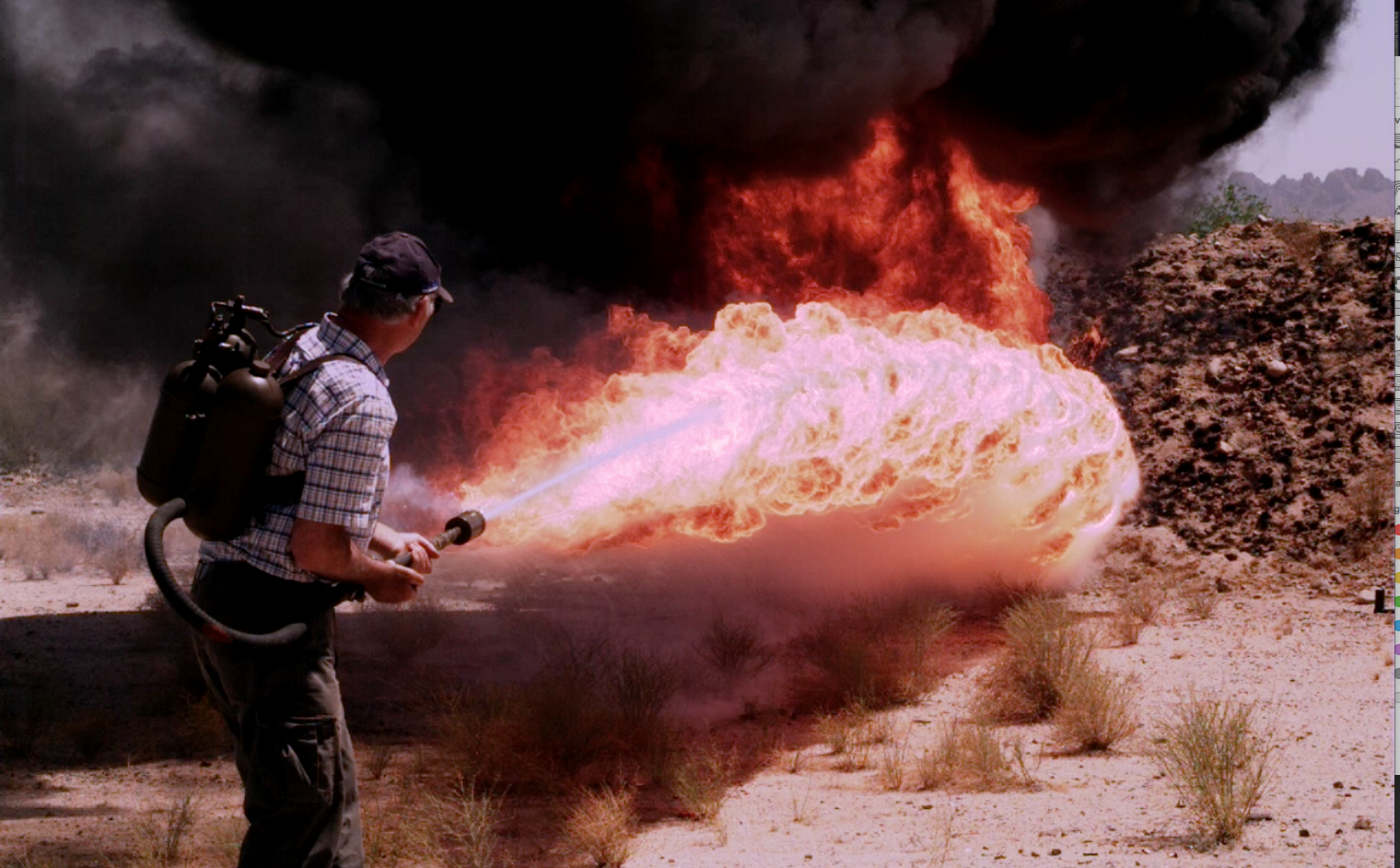 The Banzai group of Japanese weapon collectors has been around for a long time – they began publishing their newsletter in 1982 (actually, that makes the newsletter older than I am, to some peoples’ chagrin). In 1987 they published the first of what would become many Special Projects – books on specific subjects related to Japanese arms. I have previous reviewed a later one of these books (The Early Arisakas), and today I’m taking a look at the very first of them. Special Project #1 was a short booklet compiling all the available data on the Siamese Type 46 and Type 47 Mauser rifles and carbines.
The Banzai group of Japanese weapon collectors has been around for a long time – they began publishing their newsletter in 1982 (actually, that makes the newsletter older than I am, to some peoples’ chagrin). In 1987 they published the first of what would become many Special Projects – books on specific subjects related to Japanese arms. I have previous reviewed a later one of these books (The Early Arisakas), and today I’m taking a look at the very first of them. Special Project #1 was a short booklet compiling all the available data on the Siamese Type 46 and Type 47 Mauser rifles and carbines.
These weapons are relatively uncommon, but still available to the collector, and there is very little information on them. In this book, Francis Allen and Roger Wakelam discuss the history of the design and its use by the Siamese (now Thai) military. They then use a survey of 58 Type 46 rifles and 12 Type 47 carbines to draw conclusions about the different variants of the guns, and they discuss some of the accessories to the gun (slings, muzzle covers, bayonets, and cleaning rods). Finally, an article on the Type 45 and Type 66 cartridges (8x50R and 5x52R) written by Bill Woodin (world-renowned cartridge expert) is included. Put together, this pretty much covers everything US collectors have been able to discover about the Siamese Mausers.
Unfortunately, the book is out of print today, and I have been unable to locate any retail dealer or source to purchase copies. I got mine from another collector, and that’s about the only option available. However, the second-best source of information on Siamese Mausers IS available and in print – it is Banzai Special Project #8, on the Type 38 Arisaka. The Siamese guns were built under contract by the Tokyo Arsenal (and have many features copied from the Type 38), and the Banzai study of the Type 38 includes a short chapter on them. As a bonus, it also includes a wealth of information on the Arisaka. 🙂
Interested parties can order The Type 38 Arisaka from Castle-Thunder.com.



At some point in my misspent youth – must have been in the early 70s, although I may have seen it in my collection of pre-68 GCA American Rifleman magazines – I remember seeing ads for “sporterized” Siamese Mausers with a very plain sporter stock that had been rebarreled to .45-70 to take advantage of the rimmed extractor. Don’t think they made very many of them (I’ve never seen one) and I have no idea how well they worked but it was one of those odd/ cool things that stuck in my mind.
Totally off-topic, aside from odd/ cool guns… I heard about this on PRI’s “The World” a couple of nights ago and when I went to look it up I decided I liked the link to the BBC story better:
http://www.bbc.co.uk/news/magazine-25727080
I knew India made a .32 S&W Long Webley for civilian use, but now they have a titanium version for women to carry. A titanium .32 Webley… definitely cool, even for two grand.
Yeah, one of the reasons for Siamese Mausers being fairly uncommon now is that when they were imported in the 60s, an awful lot of them were sporterized and converted tomore common rimmed cartridges, like the .45-70. I haven’t shot any, but my understanding is that the conversions generally work just fine. The Siamese Mausers were popular for that because they were already designed for rimmed rounds – the extractor is set up for them, and the magazine is slightly staggered, to prevent rimlock.
Jim,
I owned one of the sporterized Siamese Mausers for several years. Although I generally frown upon sporterizing military arms, it was a great platform for the .45-70. Along with the Ruger No.1, it was one firearms which could handle the hottest .45-70 loads. It had a heavy-duty barrel and was one of the most accurate .45-70s I’ve seen.
I really regret selling it, but then that is the case with 99% of gun sales.
Forgot to mention, it could also hold 4 rounds, 3+1 in the chamber. It had a trap in the buttstock to hold 3 more rounds.
I did a quick web check after I posted and apparently they are a lot more common than I realized. Prices all over the map – up to over a grand – but I saw one that had just sold for a little over $400. That was the thing I remembered from the ads I saw way back when – they were extremely cheap for something so unique, a hundred bucks or so (very plain uncheckered wood stock and iron sights) but that was about half the price at the time of a new “Western Field” house-brand Winchester .30-06 bolt action.
If it’s that old, might be worth checking if anybody renewed the copyrights on it. If not, it’s in the public domain and you can put a copy online.
Unfortunately, copyright laws in the U.S. say that a copyright only has a chance to expire 70 years after the original author has died, and even after that it can still be removed. I’m not sure how the laws apply to the rest of the world, and it would be great if foreign copyright laws were different so that we could post a copy, but from an Americans stand point it’s way too early to be public domain.
For those interested in reading about these guns and other Siamese/Thai weapons, the author of the book Ian reviewed has notified me that “a greatly expanded and updated version – including a review of all Siamese/Thai weapons from 1860-2014 – will be released sometime this spring”.
I have a fairly good selection of Siamese/Thai rifles, bayonets and ammo in my collection and will add them to my website (www.nambuworld.com) when time allows. My work has been too crazy to allow me to get to it for some time.
Thanks for the heads up Teri, I look forward to it!
I have….and believe to be one of the Siamese Mausers……it came in a 300 gun, collection. The collector was really eclectic in in acquisitions.
25) Chinese Type 24 Mauser M98 bolt action military rifle in 8mmx57 w/24” barrel (poor worn bore). Gunsmith repaired crack in walnut stock near reciever (see pix) and lots of handling marks. And a un-repaired crack up by bayonet attachment. There is also a Chinese Arsenal stock repair behind the receiver tang (sheet metal nailed to stock). Sling swivels. Chinese Gear logo marking on receiver bridge and dated 1934. Orig. InterArmCo import company safety tag. Chinese Army marking branded in stock on the right side. All matching numbers, except the bolt. s/n L5325 $295
Bubba the Gunsmith: now available in Red Chinese!
The description, especially the 8×57, does sound like a typical Chinese Mauser. The US captured metric craptons of these in Korea. The Chinese basically gave freshly surrendered Nationalist troops a chance to work their way into Mao’s good graces by joining the Revolution, and attacking US and ROK forces. Entire units, junior officers and all just reflagged from Chinat to Chicom in 1949. Senior officers didn’t get the same deal.
One of my uncles sporterized one to 30/40 Krag. Used handloads that close to 30/06 in fps use the same bullet. While hunting with him I do remember it jamming once.
But what I remember happening more often, was him shooting it about as fast as most people shoot semi-autos. The first time we couldn’t see him and thought someone else had gotten in on our drive and was shooting a Remington 742. I think that the time it jammed he might have loaded in incorrectly.
The 8mm Siameese cartridge was developed for Siam in Copenhagen, on the 8 mmdanish Krag round.he danes, and the Siameese kingwere friends. a dane were cheef of the Siammeese Navy, as were the director of the electrical powerplants and the railways of Bankok.
For those interested Frank Allen, Roger Wakelam and myself are in the process of up-dating The Siamese Mauser (Banzai Special Project #1)
We have been working on brand new information acquired from Thailand and other collectors out there.
This book will have over 100 pages of stuff including color photos, variants, ammunition, reloading (my biggest input), original photos of soldiers with them, etc.
We are hoping to have the book out by the end of this year.
Outstanding! If you are willing, I would love to get a review copy when it is ready for publication…
The book is now out ….
“A Study Of Siamese / Thai Type 45 & Type 46 Long Rifles and Type 47 Carbines, Including An Overview Of Siamese/Thai Weapons 1860–2014”, the much revised and greatly expanded book at last answers the question of why two different designations have been used for the rifles, as well as delving in much more detail into the histories and details of both the rifles and carbines than the earlier version. The book contains numerous color pictures of the rifles and carbines, part variations, and markings, as well as historical black and white images of the weapons in use in Siam / Thailand.
Bayonets, ammunition, muzzle covers, and other accessories are covered in great detail.
A comprehensive re-loading chapter covers both the 8x50Rmm Type 45 and 8x52Rmm Type 66 cartridges. Appendices detail rifles, carbines and handguns employed by the Siamese / Thai military services from 1860 through 2014. This subject has not been covered in any other publication.
* Only 150 copies are planned to be printed. *
Cost: $37.00 which includes First Class postage within the U.S.
Ordering: The book may be ordered by mail from:
Francis C. Allan
20 Courtney Place
Palm Coast, FL
32137-8126